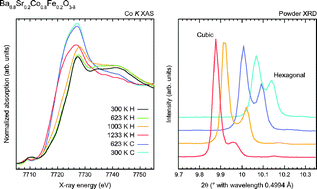Four compositions of Ba1−xSrxCo1−yFeyO3−δ were studied for phase, oxygen uptake–release, and transition metal (TM) oxidation states after solid state processing and with in situ heating from 300 to 1273 K in air. X-Ray diffraction showed that all compositions except one had the cubic perovskite structure at all temperatures; that with x, y = 0.2 was a mixture as prepared, becoming predominantly cubic at high temperature. Thermogravimetry showed a reversible oxygen absorption–desorption of approximately ±1% from 700 to 1273 K. X-Ray absorption and Mössbauer spectroscopy showed a majority TM3+ valence, with at most 40% TM4+. Up to a temperature of 1073 K, the TM4+ was reduced to TM3+. Further heating of the composition with x, y = 0.2 to 1233 K resulted in the reduction of Co3+ to Co2+. Results from room temperature measurements confirm the thermally activated carrier hopping mechanism with charge fluctuations, while the high temperature delocalized carrier conductivity occurs with a small amount of TM reduction and without phase change for the initially cubic samples.

You have access to this article
 Please wait while we load your content...
Something went wrong. Try again?
Please wait while we load your content...
Something went wrong. Try again?


 Please wait while we load your content...
Please wait while we load your content...